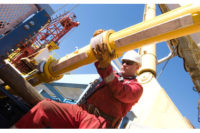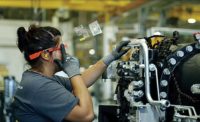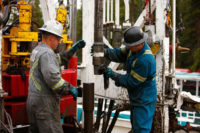When most people think about Christmas trees, they imagine bright lights and delicate ornaments. But, in the oil and gas industry, a “Christmas tree” is a critical piece of equipment that can be difficult to assemble.
The device consists of a wide variety of pipes, valves, meters, sensors and hydraulic systems that control the flow of oil and gas out of wells. It is a complex assembly that contains hundreds of parts that must operate reliably under extremely harsh conditions.
Solar panels and wind turbines may be media darlings these days, but oil and natural gas are still our dominant energy sources and will remain so for the foreseeable future. Indeed, the never-ending quest for new sources of oil and gas has manufacturers of drilling, pumping and processing equipment running full-tilt.
According to a recent study conducted by the Freedonia Group Inc., global demand for oil-field equipment will rise 4 per-cent annually through 2016 to $109 billion. “Growth will be strongest in developing areas, where better infrastructure will benefit drilling activity,” says Elliott Woo, an analyst at the Freedonia Group. “New, more expensive techniques to drill for unconventional reserves, such as shale oil and oil sands, will also boost spending on oil-field equipment.”
However, there is currently a glut of oil and gas equipment, claims Chris Faulkner, CEO of Breitling Oil and Gas Corp., an independent exploration and production company. “The market is pretty competitive right now for the first time since the ‘shale gale’ began. A 3 percent increase in rigs drilling for oil was eclipsed by a larger decline in natural gas rigs in North America, where count is down 26 percent from the same period last year. [The industry is shifting] away from gas to oil in an effort to make the economics of drilling work.
“It takes far less fracking horsepower to crack open an oil-bearing formation than it does for natural gas zones,” Faulkner points out. “All of the horsepower and frack kits were built with natural gas fracking in mind. Now that we have switched focus to oil, there is a huge glut of that equipment on the market. This trend will continue in the near-term.”
As conventional oil reserves experience a production decline, more unconventional reserves will need to be tapped. Key targets include natural gas fields in Alaska and the Rocky Mountains, oil sand projects in Canada and offshore drilling in the Arctic region.
Another controversial and technically complex initiative involves deepwater drilling. According to a recent report by GBI Research, new offshore rigs are capable of drilling in water depths exceeding 5,000 feet. And, it will soon be possible to drill in water up to 12,000 feet deep.
The discovery of harder-to-reach oil and gas reserves has forced petrochemical engineers to develop new extraction techniques and increasingly complex drilling operations. For instance, shale reserves, such as the Bakken field in North Dakota and the Marcellus field in Pennsylvania, tend to be accessed through horizontal drilling techniques, which cost more per foot than traditional types of vertical drilling.
Hydraulic fracturing equipment is needed to extract shale oil. It includes high-pressure hydraulic pumps used to push fluids and proppant into a well formation, in addition to fuel tanks, structural brackets, hoses and mufflers. Well completion units typically use a 2,500-horsepower high-pressure pump equipped with a transmission, a radiator and a silencer to mitigate engine noise.
To reduce the impact of drilling on the environment, the oil and gas industry has embraced new technologies, such as multi-pad drilling, closed-loop fracking, water recycling and desalination of salt water for use in fracking.
According to Faulkner, the average drilling rig found anywhere in the world today is about 25 years old. “While this tech-nology may have been appropriate for extracting the easy-access oil that was right below the surface, as these reserves dry up companies are looking to drill in deeper water and harder-to-reach onshore reserves,” he points out. “This requires more complicated technology. The majority of the rigs we have in operation now will not fit the bill.
“Rig contractors and exploration companies worldwide are beginning to invest in new rigs,” claims Faulkner. “This spending has been met with high demand, as oil-field equipment companies are increasingly seeing record-level orders and backlogs for new and upgraded rigs.”
Diverse Equipment
All that activity is good news for upstream oil and gas equipment manufacturers. In fact, several companies have invested in new production facilities to ramp up for new demand.
For instance, Halliburton Co. recently opened a $65 million, 200,000-square-foot assembly plant in Lafayette, LA, to produce complex components for oil-field service operations. Forum Energy Technologies Inc. is building a $19 million assembly plant in St. Martin, LA, to make drilling equipment. Weatherford Artificial Lift Systems Inc., a manufacturer of oil-field drilling equipment, recently began building a $100 million assembly plant in Katy, TX.
The United States is the biggest producer of oil and gas equipment, accounting for 45 percent of global production in 2011. Much of that equipment is exported to onshore and offshore drilling sites in Africa, Asia, the Middle East and South America.
Several hundred firms manufacture oil-field machinery and equipment worldwide, including large players, such as BakerHughes, Halliburton and Schlumberger.
However, small- and mid-sized companies dominate the industry, with many firms specializing in mass-produced items, such as compressors, gauges, pumps and valves. More complex products are typically built in smaller batches, including drill bits, manifolds, drilling motors, flow meters, Christmas trees, wellheads, pressure vessels and separation systems.
The oil and gas industry also relies on custom-built off-road trucks that are used for hauling rigs and servicing oil and gas fields in severe climates. The massive vehicles typically feature heavy-duty suspensions, oversized tires, 6x6 and 8x8 drivetrains, and tandem-steer axles that make it easy to traverse rough terrain such as frozen tundra, tropical rainforests or desert sand dunes.
Oil and gas equipment comes in all shapes and sizes. But, most products are big and bulky. They are assembled from heavy metal castings and machined components. Often, subassemblies are built and tested in factories, but final assembly takes place out in the field.
“Most assembly is high-mix, low-volume,” says Quarterman Lee, president of Strategos Inc., a lean manufacturing consulting firm that has worked with oil and gas equipment manufacturers. “Much of it involves high-strength, corrosion-resistant alloys. Size varies greatly, as well, ranging from wellhead castings that are more than 10-feet tall of 0.5-inch rods and fittings.”
All equipment must be robust. That’s because the oil and gas industry is synonymous with harsh operating environments that range from gas fields in Siberia to oil wells in Saudi Arabia.
Down-hole equipment, such as drill bits and monitoring equipment, must be engineered to withstand intense heat, pressure, vibration and corrosion. For instance, it’s not uncommon for operating temperatures to reach more than 500 F.
“Crude oil is very corrosive,” says Morgan Gallagher, an applications engineer at EWI who previously worked in the oil and gas industry. “And, the deeper it is, the hotter it is.”
Subsea drilling operations also pose unique constraints on equipment. Although many products appear similar on the outside, there is a lot of variation in oil and gas equipment, especially when it comes to surface vs. subsea applications.
“Reliability, more so than robustness, is an important aspect of oil and gas equipment that operates [under water],” says Gallagher. “Subsea equipment is expected to be extremely reliable, since it is difficult, costly, and in some instances impossible to perform repairs on components on the sea bed.
“The design of subsea equipment does not vary much from one major oil company to another,” adds Gallagher. “For instance, an umbilical for Exxon probably doesn’t differ radically from an umbilical that is used on a Chevron platform. However, in most instances, each bid and fabrication job will feel like a custom application.
“The reason for this is that each major oil and gas company has its own set of specifications that supplement industry standards,” Gallagher points out. “All equipment has to comply with both industry standards and [the customer’s] specifications. For this reason, the assembler or fabricator has to treat most jobs like it’s ‘custom.’”
Assembly Challenges
Most oil and gas equipment is manually welded to ensure high-strength, leak-tight joints. “The bulk of welding [applications in the industry] use similar joints and involve joining one type of material to itself,” says Gallagher. Manual arc welding is widely used.
“There is a lot of equipment that [requires assemblers to bend and weld] tubing into very tight areas,” adds Gallagher. “As a result, access to perform those welds is restricted. The oil and gas industry has very skilled manual welders who often [excel at] this challenge. For example, imagine someone welding with their opposite hand behind a part while using a mirror to see. In addition to skilled manual welders, there is automatic tube welding equipment with a very small footprint that is used for this purpose.
“In the oil and gas industry, lasers are currently used most frequently for cladding, as opposed to welding,” explains Gallagher. Cladding is the application of one metal to the surface of another metal, usually for the purpose of bolstering the corrosion- or wear-resistance of the component.
“There [has been] a lot of recent interest for cladding on oil and gas components,” adds Salay Stannard, materials engineering manager at Joining Technologies Inc. “Because these parts are used in caustic environments for hours on end, manufacturers are looking for ways to extend component life cycle. One solution is to [add] wear- or corrosion-resistant coatings to the surface.
“The material can either be the same as the base material or engineers can elect to go with a material that has a higher hardness value, improved thermal expansion coefficient or metallurgical properties,” explains Stannard. “We’ve [also] seen interest in using super alloys and carbide matrix materials [because of] their improved mechanical properties.
“Laser welding offers a low heat input to the component,” Stannard points out. “For oil and gas parts that are either used in instrumentation or in-line monitoring, this can be extremely important. The same applies when we utilize laser cladding. The laser cladding process has lower dilutions, while still achieving the metallurgical bond needed.”
Nd:YAG and other near-infrared lasers have proven more effective than CO2 for joining oil and gas equipment, since the latter require keyhole welding which results in a great deal of porosity.
Electron beam welding is also used to assemble some oil and gas equipment. “It is done under vacuum, while laser welding is open atmosphere with local gas coverage at the weld joint,” says Stannard. “Having electron beam capabilities allows materials that are prone to oxidation to be welded, such as titanium.”
Like aerospace and medical device manufacturers, oil and gas equipment assemblers must adhere to stringent quality standards. “Many [products] require qualification and validation to specific industry standards,” says Stannard.
Key industry standards include the ASME Boiler and Pressure Vessel Code; ISO 10423:2009, which applies to wellhead and Christmas tree equipment; and NACE MRO 175/ ISO 15156, which covers sulfide stress crack and stress corrosion cracking resistance.
“It is important to ensure the there is a good fit-up between the components to be welded,” notes Stannard. “Having a press-fit joint enables control of the weld puddle and ensures a sound weld. Of course, the materials must be weldable.
“Unweldable materials, like 303 stainless, are prone to cracking, pitting and generally fail,” warns Stannard. “Some materials that are prone to cracking can be alleviated by adding a filler material or welding to a material that is weldable, and flowing them together in the weld puddle.”
In addition to welding, brazing is used to assemble drill bits, reamers and other down-hole equipment. Threaded connections are also used. And, large bolts are used to join equipment such as drilling rigs and Christmas trees.
“The two main driving forces for welding, like any other engineering decision, must be economics and performance,” says Gallagher. “On the performance side, although there are many uses for very reliable threaded connections in the oil and gas industry, in pressure containing situations, threaded connections always have some chance of leaking.
“If the component, or system, is never to be disassembled, welding is [often] the best option for leak tightness,” adds Gallagher. “On the economics side, there are many instances where the cost of a threaded connection is higher than the cost of the man-hours required to weld and inspect an equivalent joint.”
Web Exclusives:
Oil and Gas Industry Adapts Lean Manufacturing
Tough Conditions Demand Tough Materials










